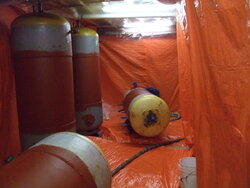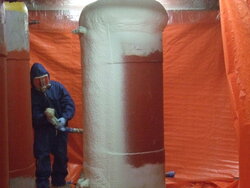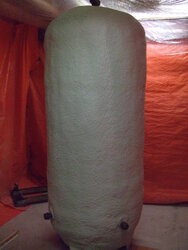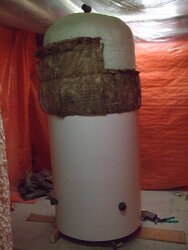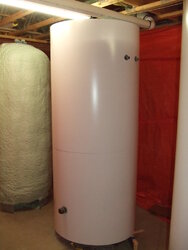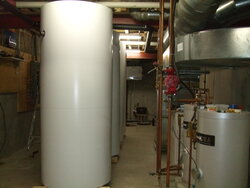I put a bigger fire in the box tonight, and got it up to about 160 degrees. But my plate HX draws some much heat from the boiler water it was sending 75 degree water back to the boiler. I don't know if that's just because the storage water started out at 65 degrees or what. But I was checking the ports of the plate HX with my temp gun and it said 155 entering boiler side and 75 leaving boiler side. I have a caleffi thermomix valve as return protection, which was working overtime. The storage side was 65 entering and 95 leaving, I'm ok with that.
If my storage is closer to target temp will my boiler return temps be better?
I couldn't seem to get my boiler much over the 160 mark while running the plate HX. I was seeing flue temps of well over 400 degrees. So I have the heat, I just need to get it into the water. I have a turbulator idea that I'm hoping will work. How much better is it to run a turbulator vs not?
I got the top of my storage up to about 110 from about 65, after a 3 hour burn. My combustion fan went into thermal shut down from getting too hot. It was cycling on and off but my damper stayed open so it would at least natural draft when the fan wasn't running. I think I need to put in another vent down low in the boiler shed to draw in cool air from outside. Do you guys think that will be enough to cool the fan down? I already made a heat sink for the fan, I'd hate to have to put a cooling fan on my combustion fan.
Here's my fan now.

If my storage is closer to target temp will my boiler return temps be better?
I couldn't seem to get my boiler much over the 160 mark while running the plate HX. I was seeing flue temps of well over 400 degrees. So I have the heat, I just need to get it into the water. I have a turbulator idea that I'm hoping will work. How much better is it to run a turbulator vs not?
I got the top of my storage up to about 110 from about 65, after a 3 hour burn. My combustion fan went into thermal shut down from getting too hot. It was cycling on and off but my damper stayed open so it would at least natural draft when the fan wasn't running. I think I need to put in another vent down low in the boiler shed to draw in cool air from outside. Do you guys think that will be enough to cool the fan down? I already made a heat sink for the fan, I'd hate to have to put a cooling fan on my combustion fan.
Here's my fan now.


 T across my plate HX. My boiler has about 20 feet of thermopex 1" to run through with a butt weld 90 elbow and a 45 degree sweat elbow, so not alot of head loss there but I'm thinking my diverter valve is adding way too much head to the boiler line. it's port for water to flow through is, at best, 1/2". so I'm thinking that is is slowing the boiler water down tremendously allowing the plate HX to do what it does and take a huge amount of heat from my boiler side. leaving me with really low return temps meaning my return protection valve stays partially closed not allowing maximum flow to my HX. could this be my problem at the boiler side of the HX?
T across my plate HX. My boiler has about 20 feet of thermopex 1" to run through with a butt weld 90 elbow and a 45 degree sweat elbow, so not alot of head loss there but I'm thinking my diverter valve is adding way too much head to the boiler line. it's port for water to flow through is, at best, 1/2". so I'm thinking that is is slowing the boiler water down tremendously allowing the plate HX to do what it does and take a huge amount of heat from my boiler side. leaving me with really low return temps meaning my return protection valve stays partially closed not allowing maximum flow to my HX. could this be my problem at the boiler side of the HX?